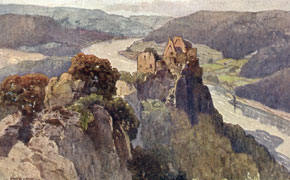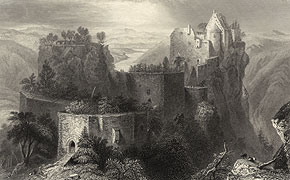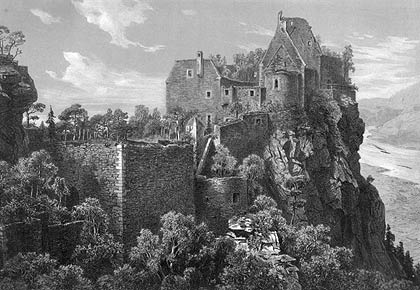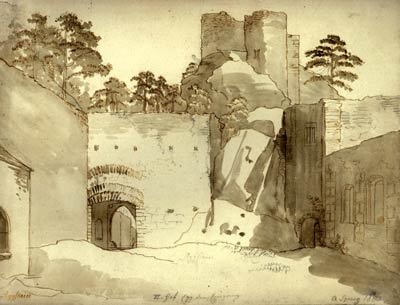|
The history of ownership |
Simultaneously carried out
archive and architectural research has led to astonishing new results,
as neither the castle itself nor its builder or even possessor can be
retraced before 1256. In the same year Perchtold von Achstein is
referred to as liegeman of the mighty nobles of Kuenring.
Thus the wild romantic staging regarding the earliest information on
ownership and construction of the castle stipulated in the 19th century, is invalid. In fact, the castle itself was only
constructed around 1200
(1st phase of construction), thus it is
not surprising that neither the Freemen of Aggsbach-Werde nor the
Freemen of Aggswald-Gansbach can be retraced to Aggstein in the 11th
and 12th century. At that time the central forest district belonged to
the famous dynasty Kuenringer, who most certainly can be considered as
initiators of the construction of the castle.
Furthermore no evidence has been found regarding the fact that the
Castle Aggstein was destroyed by Austrian Dukes due to riots caused by
the Kuenringers in 1231 und 1296. Only earlier documents recorded from
1429 mention the invasive destruction due to a conducted crime done to
the brickwork which can be verified around 1300, leading to the
extensive reconstruction of the castle
(2nd phase of construction).
The reconstruction of the castle was forfeited, due to it being
described as a “barren house” („ödes Haus“ ) and a “castle barn”
(„Burgstall“ ) in the records as well as in the construction table in
1429. The dilapidation process only coincides with the foundation of
the proximate charterhouse “Aggsbach” in the late 1300´s, by the owner
of the castle at that time, Heidenreich von Maissau, superior Schenk,
the marshal in Austria and his wife Anna. As the Carthusians did not
allow any castles to be built on their territories, they immediately
appealed against the Aggsbach Castle, which most probably brought
about the ruin of the castle.
On the 12th of June 1429 Duke Herzog Albrecht V., the later
Kaiser Albrecht II., bestowed upon his faithful valet Scheck vom Wald
“das öd Haws genant Akstain, das etwenn von untat wegen zerbrochn
worden ist und noch also oed ligt, …daz er und sein erben dasselb oed
Haws und Purkstal….wider gepawen und gemachen mugen nach iren
notdurften … (translation: this barren house and castle barn called
Aggstein broken down by a crime and still remains destroyed, so that
he and his heirs shall reconstruct it in the manner that is needed).
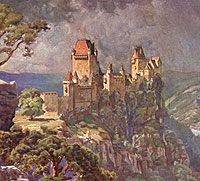 |
According to the construction
table, the reconstruction done by Scheck commenced exactly three
months later (3rd
phase of construction). The beneficence of an eternal
Mass in the castle chapel St. Georg and Kolomann marked the
completion of the construction in 1436. In 1438 Scheck was given
the privilege to raise a toll in perpetuity at the Danube
(“Donau-Maut”). |
Scheck was forcibly relieved of his
goods, titles and the castle in 1463, as he apparently misused his
rights and privileges. Soon, frightful stories entwined upon his rough
and vicious character, stories such as the legend of his “garden of
the roses” historically handed down in 1621. Even Scheck’s successor,
Ulrich Baron of Graveneck disgruntled the Kaiser by raising
insubordinate customs and tolls. From 1477 and onwards the Kaiser
employed tenants and caretakers to manage the castle.
In 1529 the castle experienced its second forceful destruction
when it was looted and ravaged by marauding Turkish troops. 2 years
later these happenings prompted King Ferdinand of Austria to not only
restore the castle but also to reinforce its fortification, at the
remarkable cost of 4000 Gulden (appr. 220.000 €) - marking the
4th
phase of construction. In 1606 Kaiser Rudolph II sold
the castle, including lordship and toll privilege to the widow
Freewomen Anna von Polheim. She decided to invest her money in the
buildings formerly held by her in pledge, in order to use them more
efficiently in future.
(5th
phase of construction).
After the Thirty Years’ War whilst the Aggstein castle was guarded by
an imperial troop, the owners of the castle altered rapidly. Towards
1765 under the reign of Sir von Starhemberg the administrative
regime of Aggstein was relocated to Schönbühel, marking the beginning
of the final architectural downfall.
In the early 19th century
Prince Ludwig von Starhemberg halted the gradual demolition of the
castle. He did this by conducting initial developmental measures (6th
phase of construction) which were continued by his direct
successor Count Franz von Beroldingen.
As from 1922 the Counts Seilern zu Aspang-Schönbühel restored
the ruin provisionally, to then lavishly develop it into a tourist
attraction in 2004-2006.
|
| Historic Environment |
The ruins of a second but smaller
castle exist just beneath the ruin of Aggstein, attaining first
mention in the archives as “Nidern Ackstein” in 1447. Apparently it
was constructed simultaneously around 1200. The purpose of the lower
castle was to control shipping traffic on the Danube and the road
traffic trailing along the river. Due to the extremely high position
of Aggstein it was unable to control the shipping, let alone block it.
Furthermore, two guard-houses already referred to in 1324 which
presumably formed a part of the toll station. The economic environment
was made up of several farms, taverns, a mill, fisheries, wood gardens
and vineyards. |
